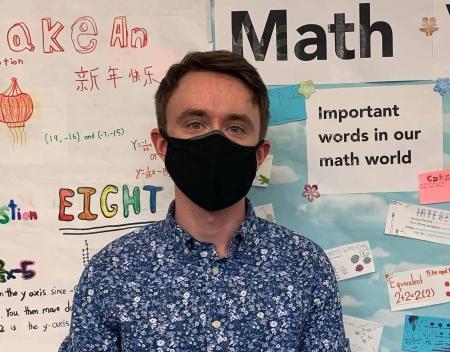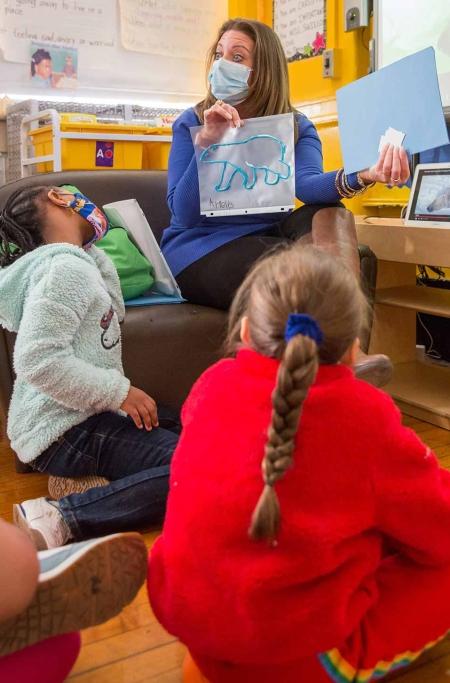Absent students and staff. Disrupted schedules. Anxiety and frustration. These five members — along with their fellow educators throughout New York City — grappled with fresh challenges as the omicron variant surged.
'Going into a battlefield against an invisible enemy'
Angela Bitterhoff, school secretary
PS 228
East Elmhurst, Queens
My life changed forever in March 2020, when I contracted COVID. The fear of dying was on my mind daily. As I fought for my life, my mother-in-law also contracted it and passed away five days later. Still today I suffer from the aftereffects. Every time a new case arose with this new variant, I would ask myself: “Was the person or child next to my desk? Did I touch something they touched?” I began to feel uneasy all over again. I asked myself, “Am I going to survive this time around if I catch this again?”
Right before the winter break, I found out that I had been exposed to someone who had tested positive. The first thing I did was to get up super early in the morning and stand in a line on a cold, rainy day for an hour and a half to get tested. That was before we received the rapid tests to take home. I’m so grateful for them since it’s a blessing to be able to administer the tests in the comfort of your own home and receive the answer right away. I feel safer and have peace of mind knowing that I have these tests.
Everyone has received additional responsibilities. I was in charge of entering all the COVID testing consent forms into the system, along with running weekly reports for the screening team that does the weekly testing at my school. Our school aide in charge of attendance used to call homes when students were absent two consecutive days; now schools are required to call home every day for every child who is absent. We used to have 10-12 students absent daily; after the winter break, we were having between 50-60 students absent.
To protect myself and members of our school community, I come in early every day to clean my work station. We open the windows to let the air circulate and always turn on our air purifiers. I always wear a mask. The office has a lot of traffic during the day, so we are constantly wiping our counters, desks, doorknobs and pens.
Going to work every day is like going into a battlefield against an invisible enemy. You never know who’s going to be the next victim.
— As told to reporter Rachel Nobel
'The city dropped the ball'
John Savarese, math teacher
IS 187
Borough Park, Brooklyn
Teaching during the omicron wave was not like anything I’ve ever done before. When we came back from the holiday break, something like a quarter of our teachers were sick or quarantined in some capacity. Everyone that I’m close with at work ended up getting COVID though, thankfully, I didn’t get it.
It was chaos. We struggled to figure out coverages. A lot of substitutes were not comfortable coming in because they saw how many people were sick. When we did get them, the kids would have multiple substitutes in a day and be either completely wired or completely burned out from the disruption.
During those first two weeks of January, five or six kids were out at a time in my classes. It may not sound like much, but the difference between 30 and 25 students is actually a lot. In one sense, it’s easier to teach fewer kids. But it created issues when they came back. You had to sort out which kids missed a quiz, which kids missed an assignment, what notes they missed.
The first week back was more or less a wasted week, instruction wise, and even the second week was just treading water. It took until our third week back from break for things to get back on track.
It felt like there was no support from the city. My school did a good job figuring it out, but it shouldn’t have been our job. Thankfully my school has been very proactive about ordering test kits and N95 masks. My friends teaching in other schools told me they didn’t have enough, or they had to beg for them.
The DOE guidance seemed to change almost every day. We did our best at our school. We developed consistent messaging for COVID exposure and contact tracing, explaining to parents how long kids would have to be out and what the procedure was. We worked out a distribution system for test kits and masks. But it’s been an enormous burden.
Thankfully, no one has died and, as far as I know, no one was hospitalized. Almost everyone who was out has returned.
I love being in the building. I just felt unsafe because the city dropped the ball.
— As told to reporter Marlow Murphy
'I just feel numb'
Jennifer Arroyo, librarian
Susan Wagner HS
Seaview, Staten Island
The teachers in my school are exhausted. What I’m hearing from many of my colleagues is that they just feel broken. As a librarian, I’m used to being able to help teachers and solve problems for them because that’s what librarians do. But I can’t pull something out of my bag of tricks to fix this situation.
When Skedula (an app to track grades and attendance) went down in mid-January, that was the nail in the coffin. I see probably 100 kids every period in the library, and I need Skedula to be able to communicate with their teachers and look up their schedules. It got to the point where we were just laughing because we were so frustrated. It was almost like delirium. How much more can you dump on us? There’s a global pandemic and, by the way, your grades are due soon but you have no way of entering them.
I expected things to be chaotic when we came back from break, but our administration did a great job distributing our rapid tests and masks. The day it snowed, we had about 90 teachers out, a large portion of the staff, and I was so impressed with the work our school did that day — they knocked it out of the park. It was all really organized.
As far as I’m concerned, we’re doing what needs to be done on the school level, but I just feel numb. We’re all very powerless in this situation. I really feel like I’m at the mercy of the mayor and the DOE. It bothers me that they seem to be changing rules to suit their agenda, to make the numbers look better so schools can be open no matter what.
I try to put my head down and work. I try not to think about getting sick and bringing something home to my elderly parents or my 3-year-old who can’t get vaccinated. I don’t know any other way to cope.
— As told to reporter Rachel Nobel
'For my 1st-graders, this is all they know'
Stephanie Nuñez, 1st-grade dual language teacher
PS 40
Bedford-Stuyvesant, Brooklyn
When the pandemic first hit, my students were frightened and anxious. But for my 1st-graders now, this is all they know — from the time they were in pre-K as 4-year-olds, it’s been like this.
My school has taken really good precautions — we decided as a school that kids would eat breakfast and lunch in the classroom, not the cafeteria; we get N95 masks and sanitize a lot and try to keep the kids as separate as possible. Teachers are sent home with testing kits, and we are encouraged to test ourselves weekly.
The most challenging thing for me is keeping up with all the changes from high up — how many days to quarantine, what it means if you’re a close contact.
I clean the classroom with disinfectants — tables, desks and their pencils — three times a day: before breakfast, before lunch and at the end of the day.
For the most part, I haven’t had any issues with attendance. The only day I had low attendance was the snowstorm on Jan. 7, when just 10 of my 17 students came in. The kids miss school when they’re out, they miss being in the classroom, seeing their friends and the teacher.
We’re here to learn, be safe and have fun. I haven’t had any students who are very anxious about omicron or COVID, but we do have conversations about keeping each other safe. They’re small, they want to hug each other and hug me, so we say, “Be safe, wash your hands, keep your hands to yourself.”
They’re fine with mask wearing. If it slips, I just say, “Pull your mask up,” and they do. I tell them, “You need to keep me safe, too, you’re not the only ones!” And they’re responsive. They’re 6 years old. Younger grades go with the flow — that’s an advantage.
Learning remotely is not the same, so my biggest goal is for students to catch up. The kids have made a lot of progress this year.
— As told to reporter Cara Metz
'The joy is gone from teaching'
Sarah Lauducci, teacher
X469@PS 277
Mott Haven, the Bronx
I’ve been a District 75 teacher for seven years, usually as an arts cluster teacher, but this year I’m in a new role teaching social-emotional learning. Essentially I help the students understand and respond to their own emotions and make sense of their experiences. Sometimes you see behaviors present themselves, and we need to determine if it’s because basic needs are not being met or there is a deeper reason.
The second half of December and first few weeks of January were less like teaching and more like damage control. Right before the holiday break, there were multiple positive cases at my site. First a few classrooms went remote, and I was part of that group. By the time we got to the four-day week leading up to the break, our entire District 75 site was remote.
Then after the break, it was chaos. Every day it was: Who’s working today? How many kids will be here? We juggled to come up with schedules. Not counting the paraprofessionals, we normally have 10 classroom teachers, five cluster teachers and a few related-service providers. One day, there were just five of us! Thank goodness, there weren’t many children that day.
It feels like the joy is gone from teaching. Everyone looks so weary. The things the kids and teachers both looked forward to — field trips, holiday shows, special events — are not there anymore. That joy is a big part of childhood and a big part of teaching.
With so many students out in January, the remaining students often weren’t in their regular classroom with their regular classmates with their regular teachers. Consistency and routines are so important for children with special needs.
The students miss each other, too. We had one student who had been out for a while. When he returned, one of his classmates grabbed his notebook that had faces with emotions on it. He pointed to his friend and then he pointed to the happy face in his book because he was so happy to see him. It was really sweet — but also really sad.
It’s not just the absences and the changing schedules, but the guidelines, the protocols, the variants. It’s an endless loop of “here we are again.” Yet teachers are still doing their best to give these kids a structured and continued education.
It’s been better recently. I write the schedule changes on a board in the office. One day this week, no staff were out. It was thrilling to write: “No schedule changes — what a great day!”
— As told to editor Joe LoVerde




